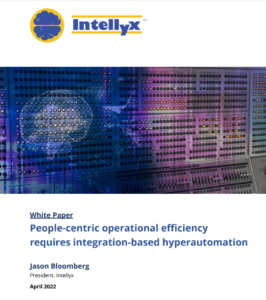Intellyx white paper for ServiceNow by Jason Bloomberg
Executives have long recognized the three primary components of a business operating model: people, processes, and technology. In the inexorable effort to improve organizational efficiency, they must target all three legs of this stool – in particular, via automation.
Automation, in essence, leverages technology to streamline and improve business processes. Such improvement, in turn, translates into greater operational efficiency, which ideally supports improved morale and lower costs.
In this rush to ever-greater achievements in automation – including the latest buzzword hyperautomation – executives risk leaving the third leg of the stool behind: people.
Fundamentally, no amount of technology will translate into significant improvements in efficiency if the people in the organization can’t effectively leverage automation across the enterprise.
The Challenges of Improving Operational Efficiency
Business leaders have been driving operational efficiencies in their businesses for years. The basic approach: optimize legacy processes and automate repetitive tasks throughout the business whenever such transformation is cost-effective.
Some executives are turning to hyperautomation to achieve these efficiency goals. Hyperautomation is a Gartner term for applying a mélange of different technologies to the automation problem, including digital process automation (DPA), robotic process automation (RPA), low-code, process mining, and rules engines.



